What do home gardeners do when the going gets tough? If you’re like me, your thoughts turn to growing foods for stocking up, and canning tomatoes are top of the list.
Come to think of it, growing varieties ideal for preserving is a good strategy in prosperous times of absolute certainty, too.
It’s always nice to have a taste of summer waiting in the pantry or freezer, or being able to turn an overabundance of tomatoes into salsa and sauce to keep on hand for neighbors and community members, or to give as gifts.
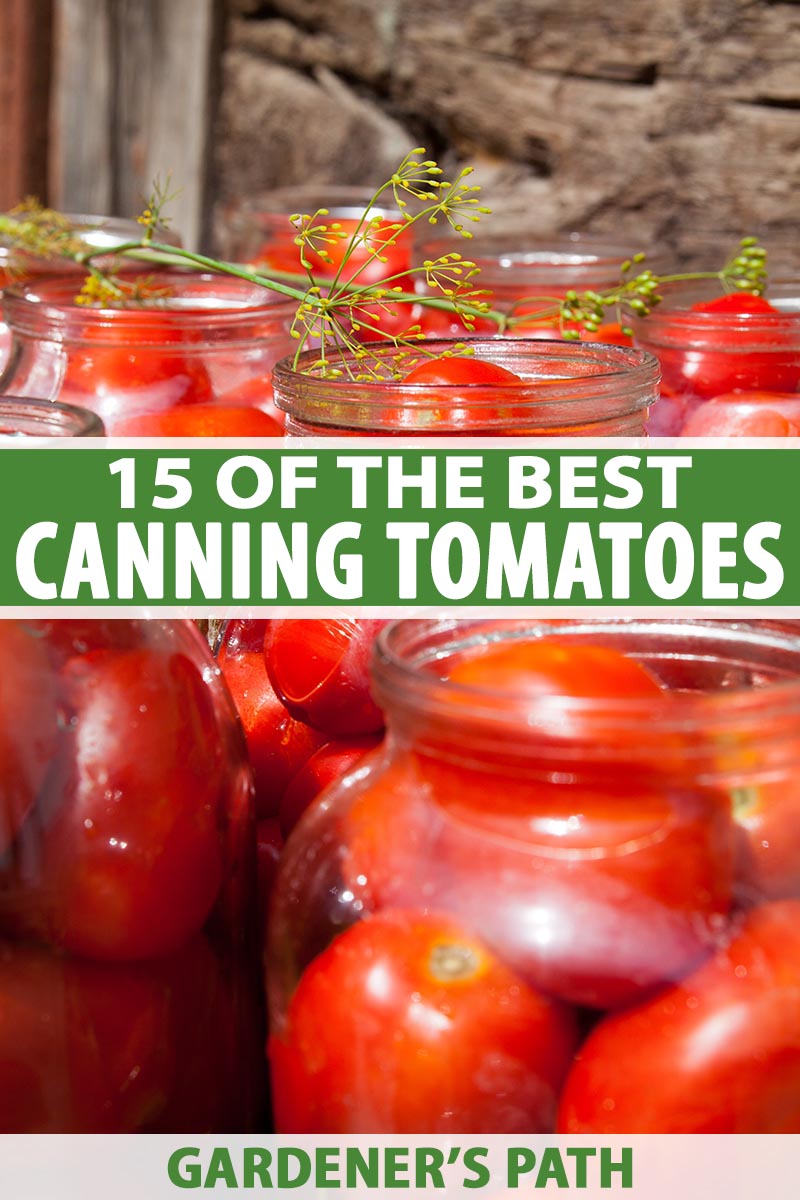
We link to vendors to help you find relevant products. If you buy from one of our links, we may earn a commission.
There’s no need to sacrifice fresh eating with most canning tomato plant choices, either.
You can slice or snack on the fruits from any canning variety, and then dedicate the rest of your produce to a session of home canning.

Before you start preparing to grow these tasty, sustaining heirloom or hybrid canning tomatoes, here’s the topline of the varieties I’ll focus on:
15 of the Best Canning Tomatoes
15 of the Best Canning Tomatoes
Why are certain varieties so good for canning? That answer comes from our sustainable gardening forebears and modern-day hybrid scientists.
Traditional heirloom canning tomatoes earned their reputation by providing fewer seeds, meaty flesh, and thick skins, all prime traits for tomatoes that home cooks would peel in a hot water bath before canning.
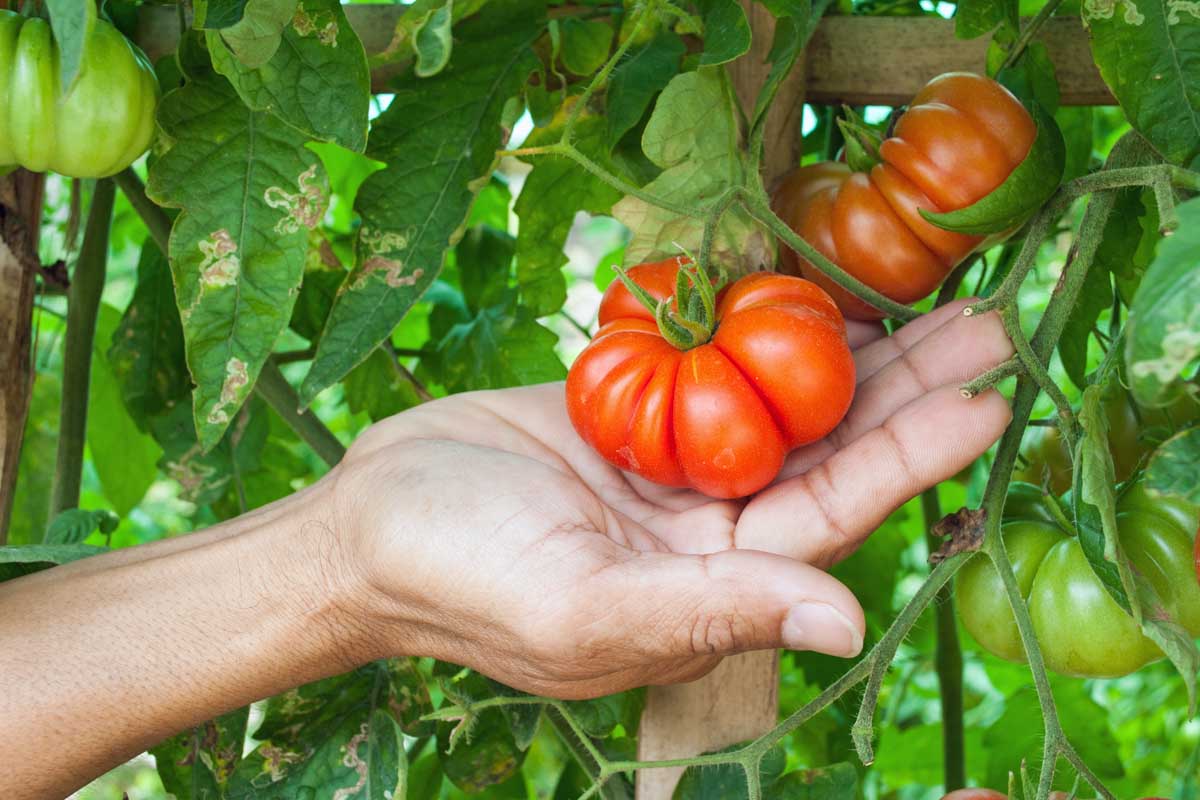
Most of the vintage varieties that were so popular for canning also had the very desirable trait of uniform size, so they’d look good in clear canning jars.
And a few, like ‘Bonny Best,’ also produced most of their fruit in a short period, maybe over a couple of weeks.
This made it simple for home canners to “put up” all the jars of tomatoes, sauce, paste, and juice they’d need in a few marathon sessions.
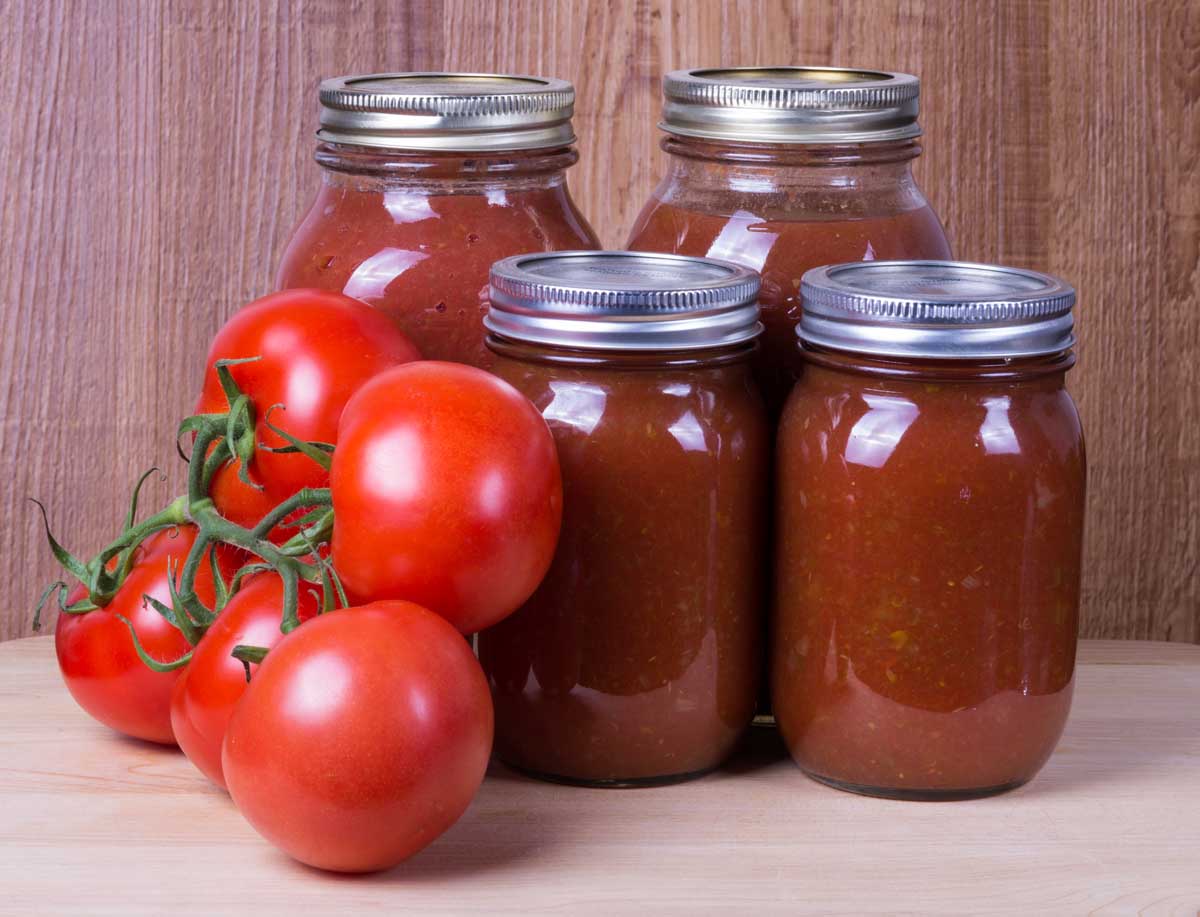
Today’s hybrid canning varieties have some of those traits, like meaty fruit with few seeds.
But they’re also bred to be more disease-resistant, and some produce larger fruit so it’s not as time-consuming to peel and seed each individual plum tomato.
Modern tomato breeders also have focused on developing commercially available hybrids that are “determinant,” for the most part.
Unlike “indeterminate” canning variety favorites like ‘Red Pear,’ the determinants typically deliver their whole harvest over the course of a couple of weeks, rather than continuing to produce throughout the season.
Read more about indeterminate vs determinate tomato plants here.
What’s great for us home gardeners is that we can choose from the whole range of canning tomato options.
There are those that fruit on a timeline that’s anywhere from 60 to 90 days, and that grow on bushy 4-foot plants, or on vines that can reach 10 feet or taller.
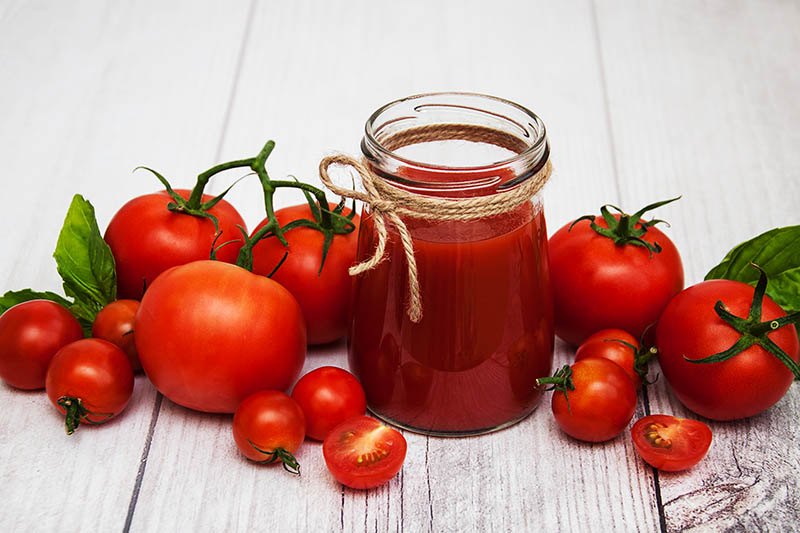
The fruits come in different sizes, too, from the giant ‘Gladiator’ to the tiny ‘Red Pear’ cultivar that’s perfect for making roasted tomato sauce or tomato pickles.
Colorful types are also an option for making unique salsas and sauces, from tiny green plum tomatoes to a hybrid golden Roma that is both meaty and sweet.
And if you’re a small-space gardener who would still like to have enough fresh produce to preserve a couple pints of, say, smoky tomato jam?
A few ‘Roma VF’ plants grown in 24-inch containers should suit you fine.
You can also plant two or three plants of the cherry variety. They’ll grow vertically and won’t require heavy-duty supports, but will still yield enough 1- to 2-inch fruits for small batch canning projects.
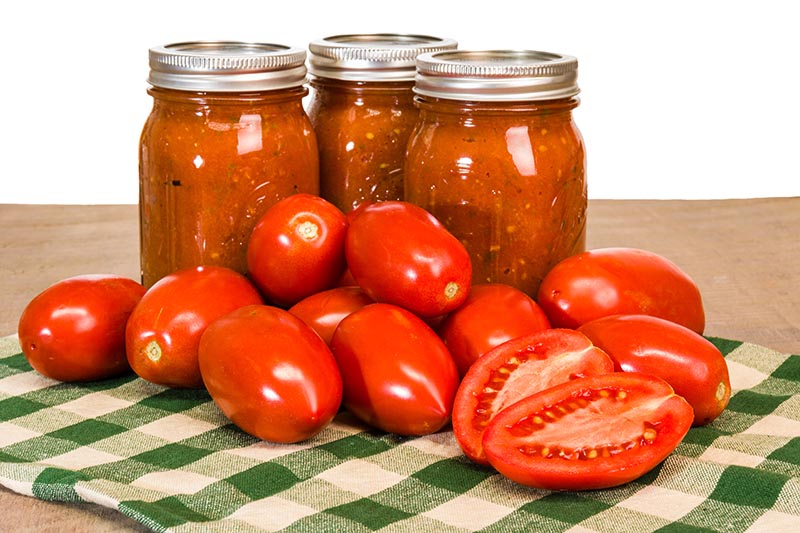
Keep in mind, though, that some canning varieties are only available if you’re willing to grow them from seed. That will require an extra 6-8 weeks before you can transplant, so plan accordingly.
And like all tomatoes, canning varieties need full sun, are heavy feeders, and require about an inch of water per week. Read our guide to growing tomatoes if you need a quick refresher, or a few extra tips.
Heirlooms
Some of these picks for great heirloom varieties date back centuries, and all have a rich heritage.
They’re also just what the home canning fan needs and wants, with their meaty flesh, sweet flavor, and thick skins.
Enjoy the growing and the stories behind these reliable and tasty heritage canning types. You can also see more of our top picks in this guide to the best heirloom tomato varieties.
1. Amish Paste
This paste variety comes to us from the Amish. Its history can be traced to Amish communities in both Wisconsin and Lancaster, Pennsylvania, and it’s at least 150 years old.
Tom Hauch of Heirloom Seeds made this variety commercially available starting in 1990.
And while the Amish developed the variety for “putting up” enough tomatoes to last the community for an entire cold winter, the fruit from the ‘Amish Paste’ cultivar are sweet enough to slice for a side dish, burgers, or BLTs.
The slightly irregular fruit just adds to this special heirloom’s appeal. Some of its 6- to 8-ounce tomatoes are shaped like teardrops, and others look more like oxhearts.
Tomatoes of this size mean a little less work than what you’d experience with larger varieties, to peel and process the meaty flesh for sauces and salsas.
‘Amish Paste’ needs staking and produces fruit 85 days from transplant.
Be sure to separate your ‘Amish Paste’ plants from other tomatoes in the garden by at least 10 feet (or preferably 50) if you want to save the seed and continue the legacy of this standout cultivar.
Seeds are available in various weight packets from True Leaf Market.
2. Atkinson
Eighteen years of research at the Alabama Agricultural Experiment Station in Auburn yielded this open-pollinated variety in 1966.
‘Atkinson’ is widely known for its resistance to rootknot nematodes and Fusarium wilt race 1, and was named for staffer and rootknot resistance pioneer George F. Atkinson.
If you sense an international flair to its tart, slightly sweet flavor, you may be reacting to one of the varieties the researchers used, a wild Peruvian tomato.
This cultivar can withstand all the heat and humidity a Southern climate throws at it while still yielding a bounty of 8-ounce red orbs. Occasionally, some of the fruit is half that size or grows to 12 ounces.
Live where it’s hot and dry? ‘Atkinson’ was bred to thrive in those conditions, too.
These plants take 70 days to produce fruit, which is a full five days less than most heirloom varieties.
They’re indeterminate, so this would be a great choice for heirloom fans who want to pursue small-batch canning throughout the season.
‘Atkinson’ seeds are available in packets of various sizes from Eden Brothers.
3. Bonny Best
This cultivar allows you to grow delicious slicers for the summer as well as canning-ready favorites that are ready to harvest at season’s end, on a single plant.
‘Bonny Best’ produces firm, round tomatoes you can slice for salads and sandwiches, but it really stands out as a provider of uniform, meaty, 6- to 8-ounce fruits at canning time.
If you’re into heirlooms, note that our forebears have been growing and preserving the scarlet red ‘Bonny Best’ since its introduction in 1908.
These plants benefit from staking and pruning, and grow 4-6 feet tall. They bear fruit in clusters in 78-85 days.
And heads up to aspiring tomato gardeners with a short growing season: ‘Bonny Best’ does especially well in cold climates.
Seeds are available in packets of various sizes from Eden Brothers.
4. Bradley
Some of the most popular types for canning are the traditional paste varieties.
Others, like ‘Bradley,’ have appeal both as a fresh-market fruit and as the main ingredient in home-canned sauces and other wonderful tomato-based recipes.
‘Bradley’ hails from the University of Arkansas and matures 75-80 days after transplant. A vigorous plant, it resists Fusarium wilt, Alternaria stem canker, and gray leaf spot caused by Stemphylium solani fungi.
It’s semi-determinate, so expect a shorter harvest window than what you’ll find with most climbing types. Nonetheless, you can anticipate continuing to pluck a few of its smooth, pink, 6-ounce fruits right up until frost.
These plants will need your encouragement. Make sure to support them with sturdy stakes or cages that can accommodate their 4- or 5-foot height and 3-foot spread.
You can find ‘Bradley’ plants in 4-inch pots from Bonnie Plants via Home Depot and six-packs also fromBonnie Plants via Home Depot.
5. Costoluto Genovese
Italians are second to none in growing sauce tomatoes. We can join in the fun with the intensely-flavored ‘Costoluto Genovese’ cultivar.
A favorite of US President and fellow gardening fan Thomas Jefferson in the early 1800s, these are delicious sliced for burgers and sandwiches.
But their flavor and high acid content are especially valuable in sauces for canning.
Don’t expect oblong plum tomatoes, though. ‘Costoluto Genovese’ produces 6- to 8-ounce brilliant red fruits with intriguing ridges on the top, and heavy lobes.
These indeterminate plants take 78-80 days from transplant to first harvest, and keep producing through the rest of the season after that.
Like all heirloom varieties, the seeds are super easy to save and share with other gardeners, who will quickly become fans of this Italian heritage canning cultivar.
‘Costoluto Genovese’ seeds are available in packets of various sizes from Eden Brothers.
Find tips on growing ‘Costoluto Genovese’ here.
6. San Marzano
This centuries-old Italian paste tomato sets the standard with its sweet, meaty fruits that star in sauces.
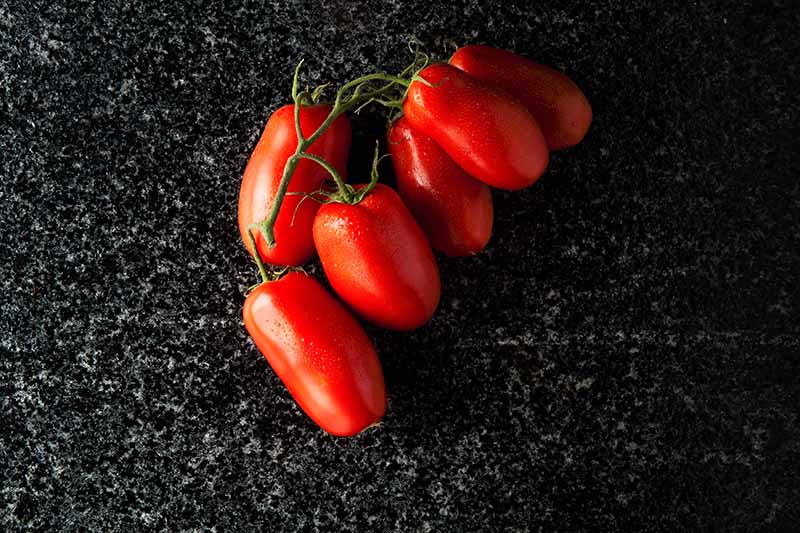
Of course, home gardeners can’t quite duplicate the flavor of those still grown in the volcanic soil from Mount Vesuvius in Italy’s Sarnese Nocerino region.
But the ‘San Marzano’ we can plant in our gardens also bear extra sweet and low-acid fruits.
They also have the characteristic teardrop shape, pointed tips, extra-thick walls, and very few seeds, perfect when you’re processing them into sauce.
You can also eat ‘San Marzano’ sliced right from the garden, chopped into a sweet fresh salsa, or roasted for side dishes or freezer sauces.
The plants available in the US are resistant to Verticillium wilt, and Fusarium wilt races 1 and 2.
If you’re going to grow ‘San Marzano,’ prepare to provide sturdy stakes or cages to prop up these vigorous vines and their heavy fruit loads.
And be patient. While the vines take 85-90 days to start producing fruit, they’re indeterminate and will keep a supply of paste tomatoes coming through the rest of the season.
You can find ‘San Marzano’ plants in 4-inch pots from Bonnie Plants, available via Home Depot.
Seeds are also available in packets of various sizes from Eden Brothers.
Read our detailed guide to growing ‘San Marzano’ tomatoes.
7. Sweetie
Cherry tomatoes typically taste best eaten straight from the vine.
But heirloom ‘Sweetie’ plants produce 1.5-inch fruits so sweet, they’ll minimize the quantity of sugar you have to add for canning sauce, juice, or jam.
The tall, indeterminate vines do best on trellises or stakes. They produce fruit 70 days from transplant, and right up to the first frost.
‘Sweetie’ seeds are available in packets of various sizes from Eden Brothers.
8. Red Pear
‘Red Pear’ proves that canning tomatoes can come in small packages, too.
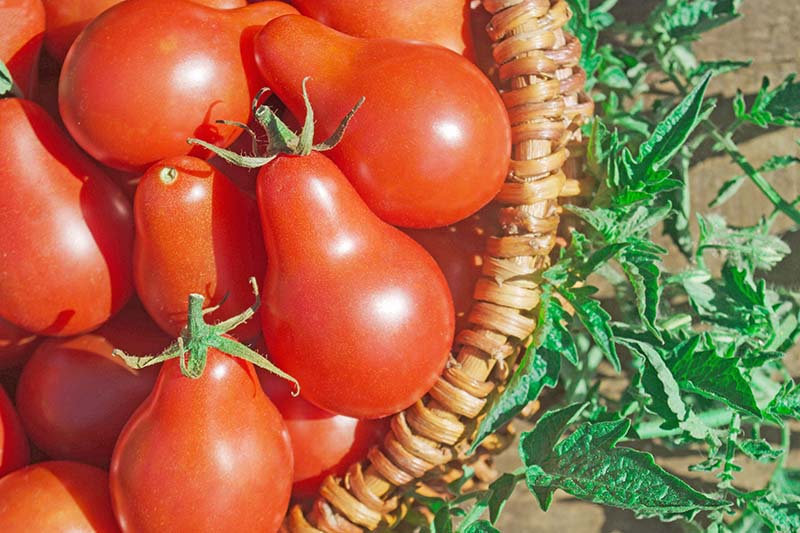
Just 1-2 inches long, the clusters of fruit from this old-timey heirloom are wonderful for preserving in salsas, sauces, and pickles nonetheless – and they may also be canned or frozen on their own to add to soups and stews all winter long.
You’ll want to trellis or stake this variety, because while the fruits aren’t heavy, the indeterminate vines can really take off skyward.
It takes these plants 78 days to produce pear-shaped fruits that are ready for picking, and they are also delicious straight from the vine or enjoyed in salads.
‘Red Pear’ seeds are available in various size packets from True Leaf Market.
Eden Brothers also sells ‘Red Pear’ seeds in various size packets.
9. Roma VF
An open-pollinated heirloom, the “VF” in the name means this plum variety resists Verticillium wilt and Fusarium wilt.

You can plant ‘Roma VF’ in a container, but make it a large one, at least 2 feet diameter. And while it’s not a particularly tall plant, growing to a maximum height of 4 feet, this one will still do better if it’s staked or caged.
Unlike ‘San Marzano,’ ‘Roma VF’ plants are determinate, so you can anticipate harvesting all of its 6-ounce fruits over the course of a couple of weeks. It bears fruit 80 days after transplant.
Then it’s game on for a modest or marathon canning session. If you’d like to stock up on tomato paste, this is the choice for you.
‘Roma VF’ seeds are available in packets of various sizes from Eden Brothers.
Hybrids
Some of the groundbreaking hybrid cultivars are newly introduced, while a few others have been saving time and preserving great taste in the home canning kitchen for decades.

These are the easiest to grow, in shapes and sizes that range from cherries to medium-sized orbs to giant plums.
You can learn more about our favorites in our guide to the best hybrid tomatoes.
10. Big Mama
Mama mia! If you’ve ever wished tasty plum tomatoes were a bit bigger, here you go.
These hybrids produce 8- to 10-ounce meaty fruits that look like your favorite ‘Roma,’ only heftier, as in 5 inches long and 3 inches wide.
If you’re dedicated to taking off the skins when you make salsa or sauce for canning, ‘Big Mama’ simplifies the effort with skin that peels away quickly after you parboil the fruits.
The vines are sizable, too, growing to about 6 feet tall and spreading 5 feet. You’ll definitely need heavy-duty stakes and a lot of canning jars to accommodate ‘Big Mama.’
Packets of 50 seeds or sets of three live plants are available from Burpee.
11. Biltmore
‘Biltmore’ represents a triumph of disease-resistance that doesn’t sacrifice flavor.
Most of its fruit ripen at the same time, and that means a predictable bounty that our grandmothers only dreamed of.
The plants reach 4 feet in height, so they are candidates for planting in whiskey barrels or other large containers on a patio.
But with all that heavy fruit maturing at once, it’s best to provide sturdy stakes wherever you plant.
Look for that onslaught of fruit to ripen 68-74 days from transplant, and then cancel all your plans while you revel in putting up the harvest.
You can find ‘Biltmore’ plants in 4-inch pots from Bonnie Plants via Home Depot.
12. Fresh Salsa
This hybrid produces the kind of fruit foodies and preservers both yearn for.
It produces oversized plum tomatoes that weigh about 5 ounces, are 2 to 3.5 inches long, and 2 inches wide.

The flesh on these is remarkable. Chopped into tiny cubes for fresh salsa, it doesn’t drip, and stays sweet and solid.
The same attributes simplify labor for those who want to make salsa by the home-canned gallon.
Determinate ‘Fresh Salsa’ bushes set fruit quickly, usually in just 65-70 days. A good pick for small space gardeners, the plants reach 36-40 inches tall and spread just 18 inches.
‘Fresh Salsa’ is available in 30-seed packets, or as a three-plant live set, exclusively from Burpee.
13. Gladiator
A garden warrior for sure, ‘Gladiator’ is a paste tomato that delivers multitudes of 8-ounce fruits on a space-saving 4-foot-high, 5-foot-wide bush.
The first fruits mature 72 days after transplant.
These plants are indeterminate, vigorous, and disease resistant, with strong roots that stave off blossom end rot.
‘Gladiator’ is available in 30-seed packets or as a set of three live plants from Burpee.
14. Golden Fresh Salsa
Just like ‘Fresh Salsa,’ these plants bear meaty, firm, water-free fruit in 70 days.
But the determinate plum-shaped fruits from ‘Golden Fresh Salsa’ are a deep, warm yellow.
Seeds are available in packets of 30 exclusively from Burpee.
15. Green Envy
Cherry tomato breeders have also made inroads into hybrid cultivars, and ‘Green Envy’ is a fun example.
These indeterminate plants grow to about 5 feet tall, and produce loads of emerald green, 1-inch, oblong fruit that matures 60-70 days from transplant.
Aside from their unusual and appealing color that pairs so well with red and yellow varieties for a bit of contrast, ‘Green Envy’ are meaty and sweet.
Chop the fruits to process for canned or frozen salsa, or roast them to make jam for freezer storage or hot packing.
‘Green Envy’ is available in 40-seed packets or as sets of three live plants from Burpee.
Can You Picture a Pantry Full of Tomato Goodness?
Whether you want to start small with a couple of canning tomatoes in a container, or go big and pack the freezer after growing a full garden of determinant heirlooms, it’s time to get growing.
And remember, if you have an overabundant harvest, that’s more to can and freeze, or to share with friends, neighbors, and needy community members.
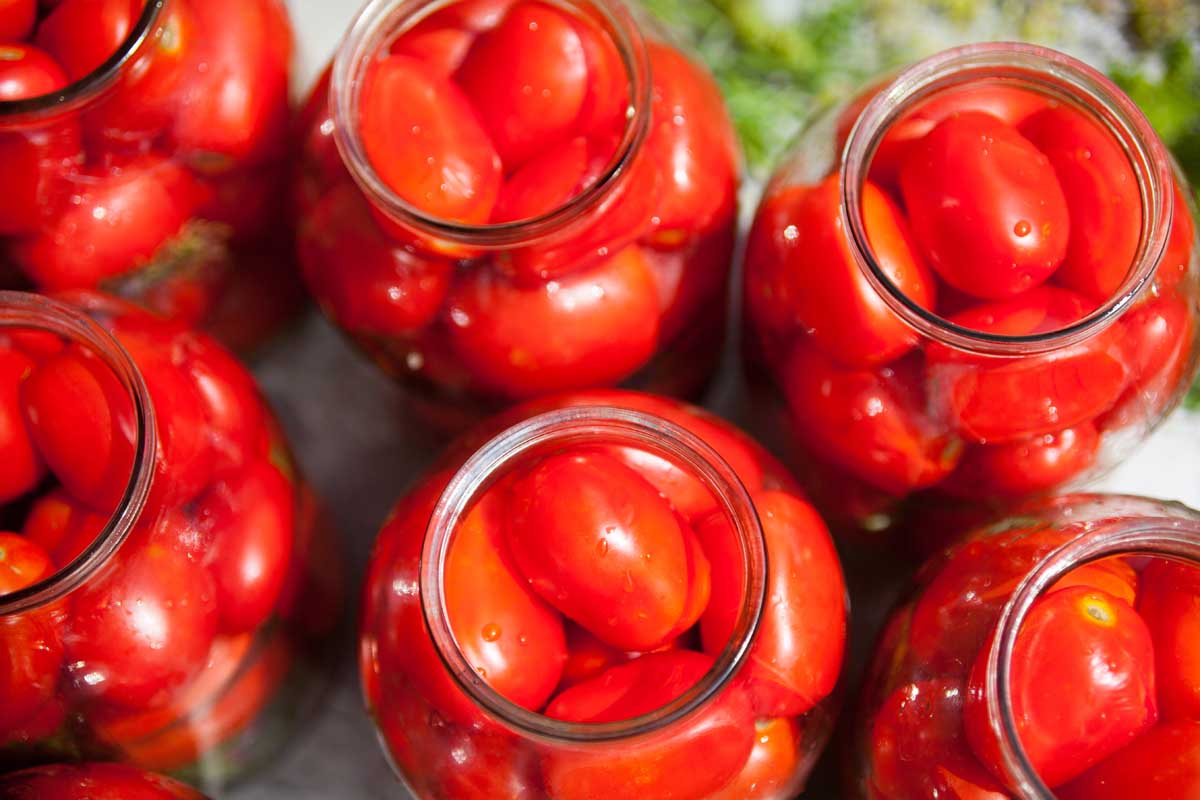
Is there really any such thing as too many canning tomatoes when you have a kitchen, water bath, and preserving jars at the ready?
I’m going to say, “Never!” But if you disagree, or have more tips for growing, selecting, or preserving, how about hopping on the comments section to share your thoughts and suggestions?
Sold on growing canning tomatoes to stock your freezer and cupboard? If so, you’ve got lots of motivation to grow your best. After all, that’s your stock of recipe-starter sauces and salsas for the rest of the year we’re talking about.
To make sure you get the highest yields and grow the healthiest plants, learn more about growing tomatoes with these guides next:
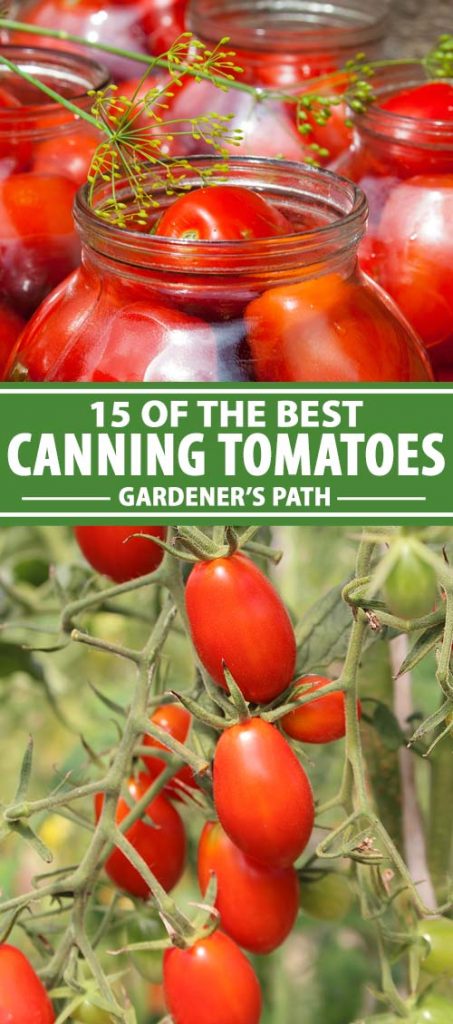
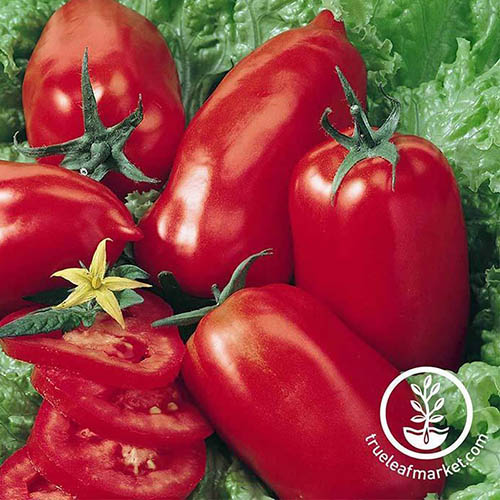
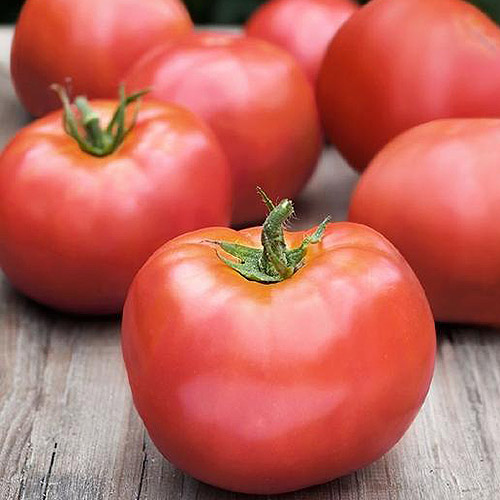
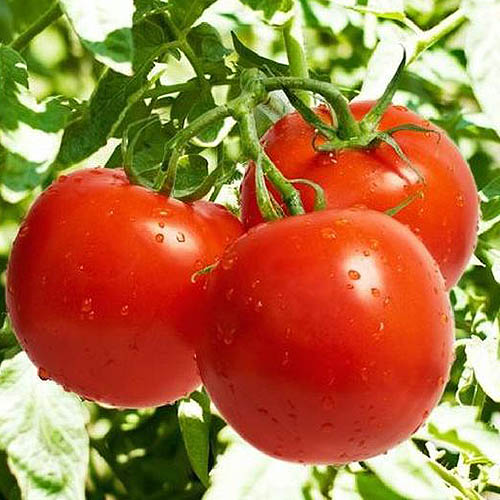
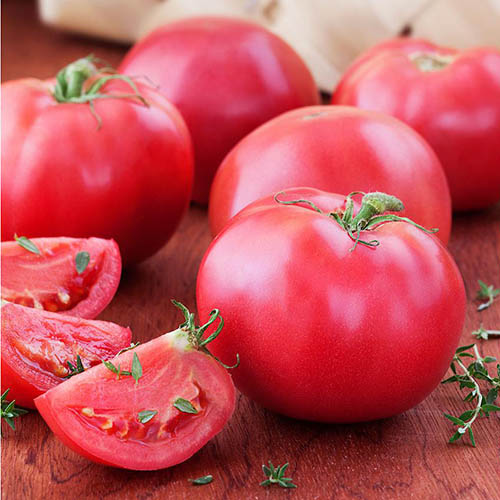
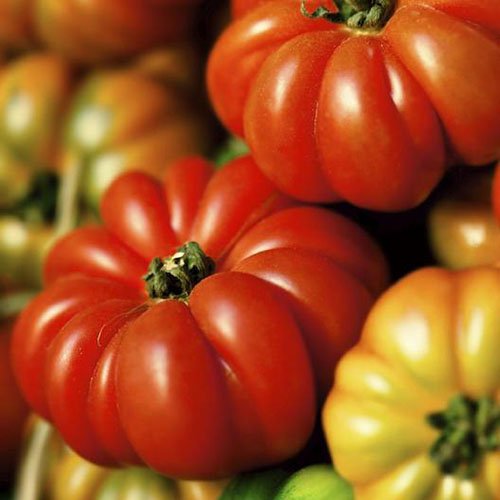
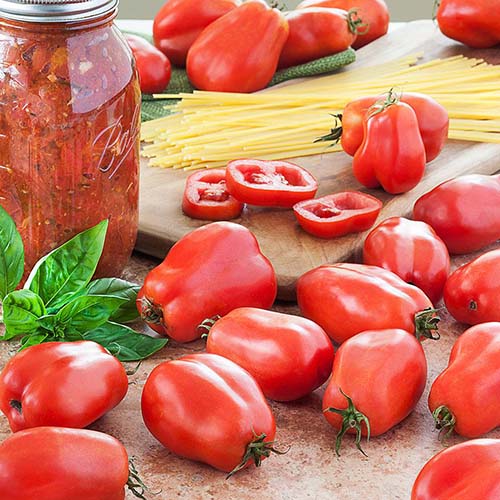
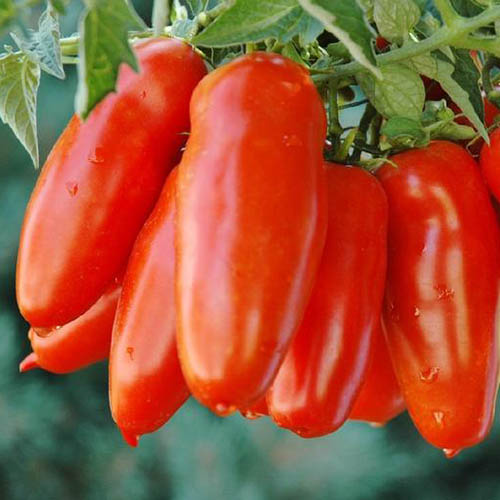
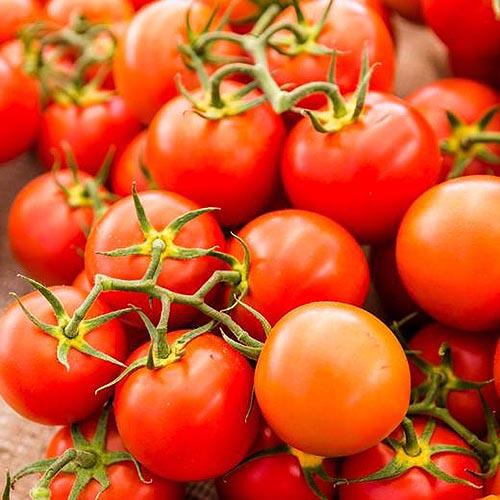

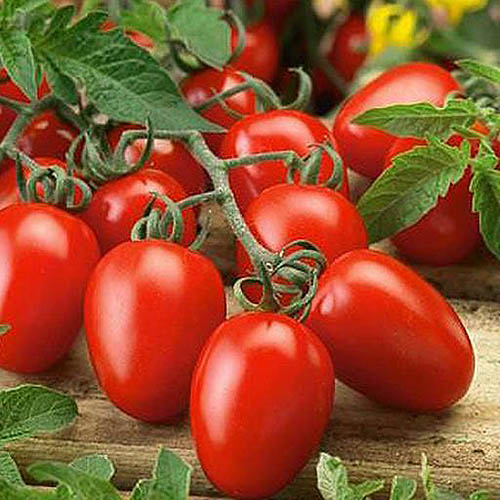
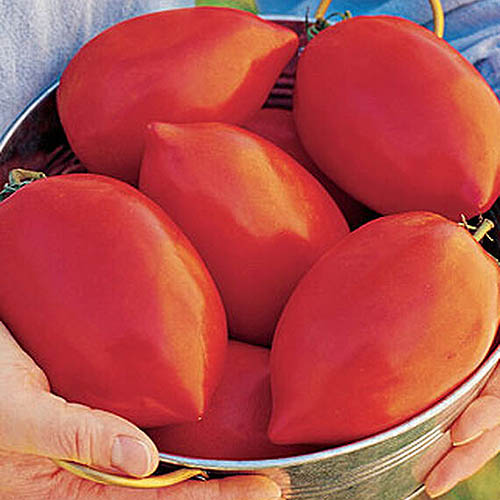
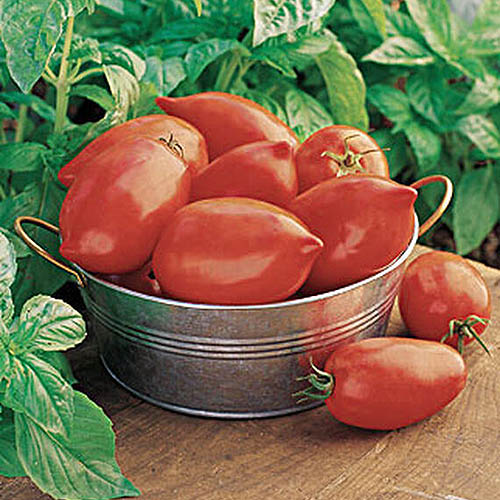
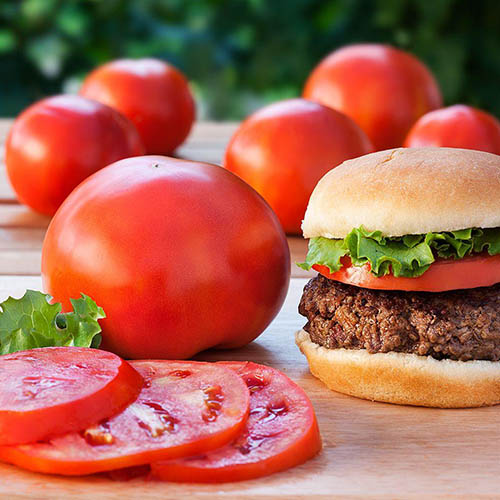
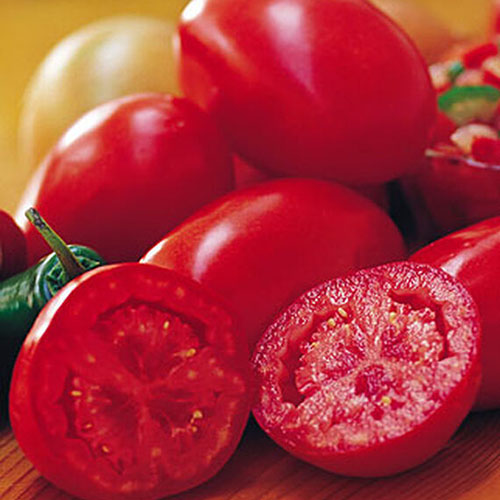
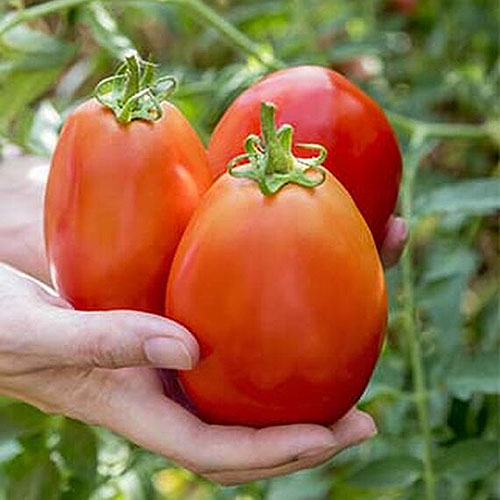
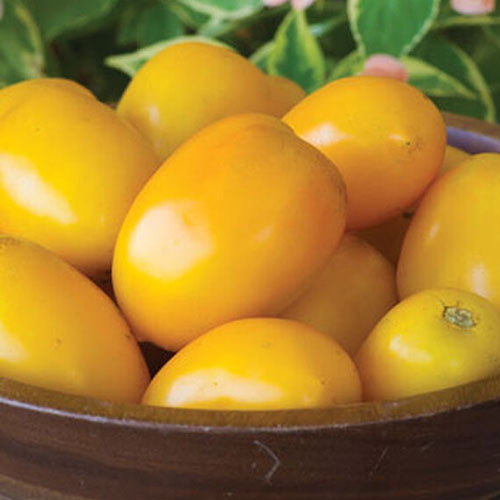
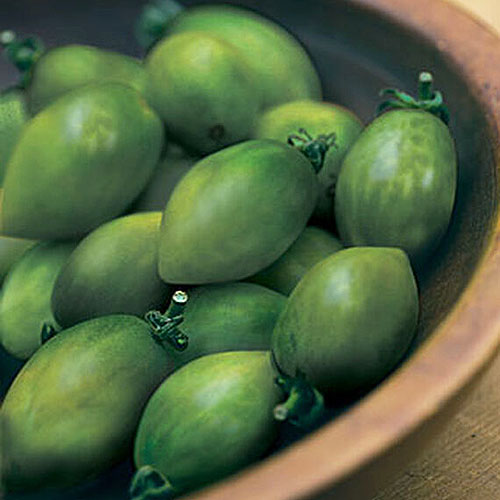

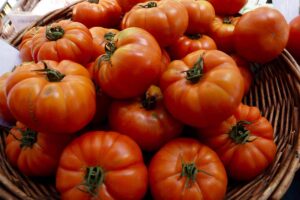
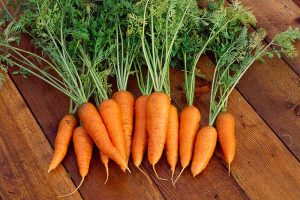
I think I just found a new favorite in the canning tomato category. ‘Mrs. Maxwell’s Big Italian’ is a climbing tomato with very large fruits that are light red. It’s unusual to find a tomato plant that grows 12 feet tall and produces beefsteak tomatoes that are also great for canning, but there you go.
Olpalka, is a phenomenal canner.
Opalka, and yes, it’s wonderful!
Very accurate description of the tomatoes! I will try some that I haven’t. THANKS
Thanks so much for the compliment. Let me know how it goes! I’m going to try this type of climbing Italian tomatoes I’ve found if I can persuade them to start from seed. ????
Does anyone know which stores sell the 3 pack Burpee plants?
Hello Kathy3882! The Burpee “Mix and Match” three-packs are available online. I checked recently and they still have some good canning varieties available. Hope you have a blast growing tomatoes to put up this year.
Hai mamm good information thanks
Thanks for reading Sunil raaj and you are so very welcome.
I have found the heirloom tomatoes, Polish Linguisa and Opalka great for pasta and salsa.
They grow well in my zone 4 climate.
We got over 300 lbs of tomatoes /25 plants
Hello Diane.
That is an impressive amount of tomatoes, especially when I factor in your short growing season there in Zone 4! I also like ‘Opalka’ with its depth of flavor and lack of seeds.
I appreciate the tubular tomato shape, too–makes it easier to chop for those big batches of salsa. Keep up the good work and maybe think of submitting a photo or two when you harvest this year?